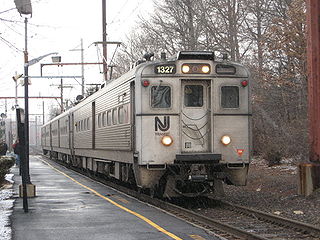
The Gladstone Branch is a commuter rail line operated by NJ Transit from Gladstone station, in the U.S. state of New Jersey, to either Hoboken Terminal or New York Penn Station. It is one of two branches of the Morris & Essex Lines.

The Morristown Line is an NJ Transit commuter rail line connecting Morris and Essex counties to New York City, via either New York Penn Station or Hoboken Terminal. Out of 60 inbound and 58 outbound daily weekday trains, 28 inbound and 26 outbound Midtown Direct trains use the Kearny Connection to Penn Station; the rest go to Hoboken. Passengers can transfer at Newark Broad Street or Summit to reach the other destination. On rail system maps the line is colored dark green, and its symbol is a drum, a reference to Morristown's history during the American Revolution.

Newark Broad Street station is a New Jersey Transit commuter rail and light rail station at 25 University Avenue in Newark, New Jersey. Built in 1903, the station's historic architecture includes an elegant clock tower and a brick and stone façade on the station's main building. In June 1984, the station was added to the National Register of Historic Places in recognition of its historical significance.
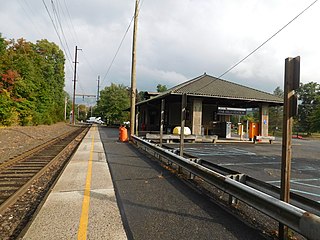
Far Hills is a NJ Transit station in Far Hills, in Somerset County, New Jersey, United States located at the intersection of Route 202 and CR 512, one-half mile (0.80 km) east of Route 206.
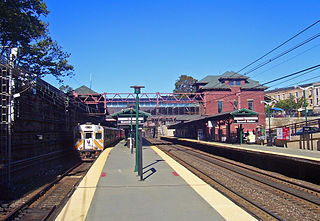
Summit is a train station in Summit, New Jersey, served by New Jersey Transit's Morris & Essex Lines. The station sits between Union Place on the north and Broad Street on the south, with station access via either side, and between Summit Avenue on the east and Maple Avenue on the west. Constructed in 1904–1905 by the Delaware, Lackawanna and Western Railroad in a mile-long open cut, it is one of the few NJ Transit stations with platforms below street level.

East Orange is an active commuter railroad train station in the city of East Orange, Essex County, New Jersey. Located next to East Orange City Hall, the station serves trains on the two lines that make up New Jersey Transit's Morris and Essex Lines: the Morristown Line and Gladstone Branch. Trains heading east to New York Penn Station and Hoboken Terminal stop at Newark Broad Street Station next, while trains heading west towards Gladstone and Hackettstown stop at Brick Church station. East Orange station contains two platforms to service three active tracks. The station is accessible for handicapped persons per the Americans with Disabilities Act of 1990.

Brick Church is an active commuter railroad station in the city of East Orange, Essex County, New Jersey. The station, one of two in East Orange, is located next to the Temple of Unified Christians Brick Church, designed with brick architecture. The other station, located 0.6 miles (0.97 km) to the east, is the namesake East Orange stop. Trains from the station head east on New Jersey Transit's Morristown Line and Gladstone Branch to New York Penn Station and Hoboken Terminal while westbound trains service stops out to Gladstone and Hackettstown. Like its sister station, Brick Church contains three tracks and two platforms. However, it is not accessible for the handicapped.

Orange is an active commuter railroad train station in the city of Orange, Essex County, New Jersey. One of two stops in the city, it is served by New Jersey Transit's Morris and Essex Lines: the Morristown Line to Hackettstown and the Gladstone Branch to Gladstone for trains from New York Penn Station and Hoboken Terminal. Orange station contains two low-level side platforms and three tracks.
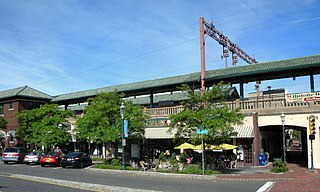
South Orange is a New Jersey Transit station in South Orange, New Jersey along the Morris and Essex rail line. It is located in the business district of South Orange, near its town hall. It is one of two train stations in the township of South Orange, Mountain Station being the other near the township border. South Orange station was built by the Lackawanna Railroad in 1916.
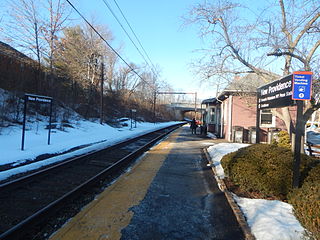
New Providence is a New Jersey Transit station in New Providence, New Jersey along the Gladstone Branch of the Morris and Essex line. The original 1899 station, built by the Delaware, Lackawanna and Western Railroad still stands. New Providence station is located across from the intersection of Old Springfield Avenue and Division Avenue. Springfield Avenue was rerouted north of the station in 1931. The former segment of Springfield Avenue on the opposite side of the tracks has been turned into an additional parking lot.

Berkeley Heights is an active commuter railroad train station in the borough of Berkeley Heights, Union County, New Jersey. Operated by New Jersey Transit, the station services trains on the Gladstone Branch between Summit and Gladstone.

Gillette is a station on the Gladstone Branch of the Morris & Essex Lines of NJ Transit in Long Hill Township, New Jersey. It is located at the intersection of Mountain Avenue and Jersey Avenue in the Gillette portion of Long Hill Township.

Stirling is a NJ Transit station in the Stirling neighborhood of Long Hill Township, New Jersey along the Gladstone Branch of the Morris and Essex line. The station consists of one side platform, as well as a concrete block shelter constructed in August 1974 after the former Delaware, Lackawanna and Western Railroad depot was demolished. The Erie Lackawanna Railroad demolished the old depot on August 14, 1972 without notifying then-Passaic Township.

Millington is a NJ Transit station in the Millington section of Long Hill Township in Morris County, New Jersey, United States, located at the intersection of Oaks Road and Division Avenue. It is served by the Gladstone Branch of the Morris and Essex Lines, and is one of three stops in Long Hill Township.

Lyons is a New Jersey Transit station in Basking Ridge, New Jersey along the Gladstone Branch of the Morris & Essex Lines. The station serves south Basking Ridge as well as the Hills and Liberty Corner.

Basking Ridge is an NJ Transit station in Bernards Township, New Jersey along the Gladstone Branch of the Morris and Essex Lines.

Bernardsville is a New Jersey Transit station in Bernardsville, Somerset County, New Jersey along the Gladstone Branch of the Morris & Essex Lines.

Peapack is an active commuter railroad train station in the borough of Peapack–Gladstone, Somerset County, New Jersey. Located on Holland Avenue in the Peapack section of the municipality, the station serves trains of New Jersey Transit's Gladstone Branch.

Gladstone is a New Jersey Transit station in Peapack-Gladstone, Somerset County, New Jersey, United States. It is the western terminus of the Gladstone Branch of the Morris and Essex line. A yard is to the east of the station.

Mountain Lakes is a commuter railroad station in the borough of Mountain Lakes, Morris County, New Jersey, United States. Serviced by New Jersey Transit's Montclair-Boonton Line, the station is the first/last station after the Morristown Line merges/diverges at Denville station. The station consists of one low-level side platform, servicing a solo track. A station depot, built by the Delaware, Lackawanna and Western Railroad, is located in the parking lot, currently serving as a restaurant known as "The Station at Mountain Lakes".






















